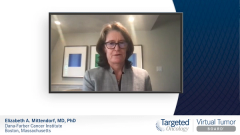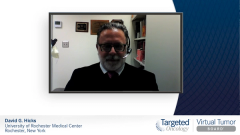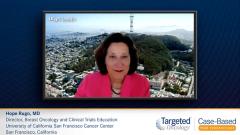
Case 2: Study Design and Data for PARP Inhibitors in TNBC
Experts in the management of breast cancer review clinical trial data using PARP inhibitors in the treatment of BRCA1/2-mutated TNBC.
Episodes in this series

Elizabeth A. Mittendorf, MD, PhD: This patient has metastatic breast cancer, and PARP inhibitors seem to work well. Ruta, what about our BRCA mutation carriers who have earlier-stage nonmetastatic breast cancer? What’s the role of PARP inhibitors there?
Ruta Rao, MD: Great question. We have ongoing trials in this area. We’re hoping to see the OlympiAD report pretty soon, which is looking at olaparib in the adjuvant setting as maintenance for patients with high-risk disease. They compared olaparib [Lynparza] for 1 year vs placebo in these patients who had a germline BRCA mutation and did not have a pathologic complete response [PCR] to their neoadjuvant chemotherapy. There are also studies with rucaparib [Rubraca] and talazoparib [Talzenna] in the neoadjuvant setting. We’re still waiting on that, but we have some excitement based on what we’ve seen in the metastatic setting.
Elizabeth A. Mittendorf, MD, PhD: There’s a lot of excitement. The last slide details some of the ongoing trials in early stage breast cancer. As Ruta just alluded to, there are 2 studies looking at olaparib. One is looking at rucaparib, and the other is looking at talazoparib. The talazoparib preoperative space is interesting to me. Before coming to Dana-Farber Cancer Institute, I had the privilege of being on the faculty at The University of Texas MD Anderson Cancer Center. I worked closely with Dr Jennifer Litton on a study where we gave a PARP inhibitor monotherapy in a preoperative setting, and Jennifer reported a fairly respectable pathologic complete response rate. What that stimulated in me intellectually was the idea that in breast cancer, if we can figure out what an individual tumor’s Achilles’ heel is, whether it’s a BRCA mutation, HER2 [human epidermal growth factor receptor 2], ER [estrogen receptor], or the presence of PD-L1–positive immune cells, that’s probably going to be the optimal strategy for treating some of these patients. That study that Jennifer reported on did lead to a larger study to look at the potential role of using talazoparib monotherapy in the neoadjuvant setting. Of course, we would still follow that with chemotherapy. If you think about it in a larger study, what will the PCR rate be? Then the question is: Are all PCRs the same? I don’t know. Do either of you have any thoughts about that? Does it matter how we get to PCR? Does getting a PCR result in improved survival for our patients?
David G. Hicks, MD: PCR is important. There’s been a meta-analysis that suggests it’s a pretty good surrogate for outcome. Our surgeons are very concerned, particularly in a patient with locally advanced breast cancer. They’re very excited about PCR or near PCR because it makes the surgery easier, so that’s a real clinical benefit. But a lot of what we know about PCR is in the HER2 space. Is it the same for triple-negative? It’s important, but we need more data.
Elizabeth A. Mittendorf, MD, PhD: Yeah. To be honest with you, we have to focus on metastatic breast cancer, but it would be great to get you both back to have a conversation and go through some cases for patients who are treated in the neoadjuvant setting. David, as you alluded to, 1 of the initial reasons to consider giving systemic therapy before surgery was to make inoperable tumors operable or for patients who required mastectomy cans for lumpectomy. As a surgeon, I’ve also learned that we can decrease the amount of surgery in the axillae, which is a positive. Ruta knows that for her HER2-positive and triple-negative patients, the response to the therapy informs which adjuvant therapy to use. It’s a tremendous advance in how we care for our patients with breast cancer.
Ruta, any final thoughts about how you counsel women with BRCA or other pathogenic mutations with respect to how their family members should potentially be counseled or screened? This will be the last thought as we finish up this case.
Ruta Rao, MD: That’s something really important that we have to discuss with the patient: what it means for their family members, their children, their siblings. We can’t forget that piece of it. That’s another place where our genetic counselor becomes a very important part of the team to help with that.
Elizabeth A. Mittendorf, MD, PhD: Yeah. I will say that with increased use of genetic testing, those genetic counselors are such a critical member of the team. I’m really pleased to hear that they sit in on your tumor boards. That’s valuable. I made a note to myself that we might want to think about that for our own discussions. All right. Any final thoughts on this case before we move on to our third scenario?
David G. Hicks, MD: Beth, if I could just make 1 final point. I know we’re talking about triple-negative breast cancer and the importance of doing genetic testing for family history and risk but also therapeutically. About 80% of BRCA1 carriers are triple-negative, but if you look at BRCA2, they tend to follow the traditional breast cancer subtypes that we see in the general population. Many of those patients are ER-positive. In terms of these drugs, we need to think beyond triple-negative so we don’t miss patients who potentially could benefit.
Elizabeth A. Mittendorf, MD, PhD: Excellent point.
Ruta Rao, MD: That’s a great point. That’s exactly why we should think about testing all our metastatic patients, whether they’re triple-negative or ER-positive. Exactly what you said, they could be a BRCA2-mutation carrier and still a candidate for some of these targeted therapies. Back to your earlier point, maybe even testing all our patients with breast cancer, especially if the use of PARP inhibitors expands to the early-stage adjuvant or neoadjuvant settings.
Elizabeth A. Mittendorf, MD, PhD: Yeah. If we’re testing all our newly diagnosed early-stage patients, it becomes a challenge for us, as surgeons, in that the technology or ability to identify mutations has surpassed our knowledge of what to do about those mutations. I feel quite comfortable counseling a BRCA1- or BRCA2-mutation carrier of what her risk of contralateral breast cancer will be, and therefore the potential benefit of prophylactic surgery. I don’t have that data to inform the conversation around CHEK2 gene or ATM gene. We’re getting it. There are more data to suggest the pathogenic nature of PALB2. More to follow.
I said we were going to move on, but now I realize that I have another question. Not necessarily from this case, but from this conversation. We alluded to it before the difference between having a germline mutation and a somatic mutation. Ruta, when in the line of a patient’s journey through treatment of metastatic breast cancer do you send the tumor for a somatic mutation to look for mutations that can inform treatment? A PIK3CA mutation may inform the opportunity to go on a clinical trial. Where does that fall into your treatment plan for these patients with metastatic breast cancer?
Ruta Rao, MD: It used to be something that we kept for later lines of therapy, but I found that we’re doing it earlier and earlier. In the estrogen receptor–positive patients, if we find the PIK3CA mutations, we know they’re a candidate for a targeted therapy. Similarly, in the triple-negative breast cancer arena, we’re always looking for a potential target. Sometimes we’re doing it earlier in these patients.
Transcript edited for clarity.











































